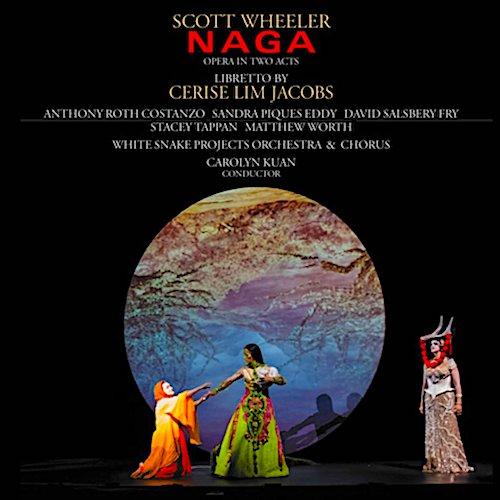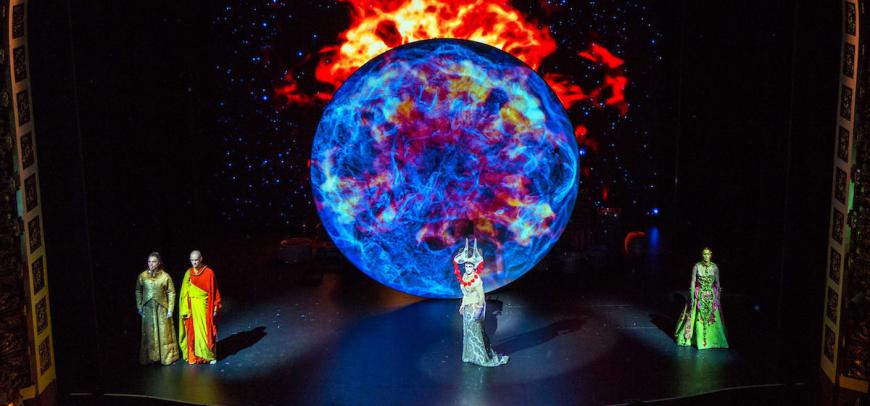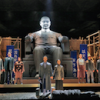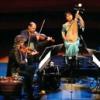
Exactly 140 after the first complete Ring Cycle was performed at Bayreuth, a new multi-opera cosmos was born. The Ouroboros Trilogy, which premiered in Boston in 2016, is one-third the length of Wagner’s cycle (five hours vs. 15) and one evening shorter, though it follows a comparable tale of heroic deeds and romantic intrigue among mythological characters. In reaction to the stain of German nationalism that still colors the Ring, this new cycle was conceived in a spirit of globalism. The three libretti by Cerise Lim Jacobs examine affinities across various folkloric traditions — specifically, how humanity has represented the figure of the Snake. The titular ouroboros, a tail-swallowing serpent that reappears throughout history as a symbol of renewal, is a fitting emblem.
While Jacobs is veritable factotum in the bygone impresario model (in addition to writing the text, she founded a company to mount the cycle), she’s not a composer. For the music, she enlisted three top American composers. Boston-based Scott Wheeler, who teaches at Emerson College, was assigned the trilogy-opening Naga — recorded live here at its premiere (New World Records, 2021). I would imagine this wasn’t an ideal position for him, having to set the tone for the two subsequent operas by Zhou Long and Paola Prestini.

But Wheeler’s prologue to Naga suggests an artist confident in his abilities. He introduces a dreamy prog-rock palette of rain stick, electric bass and guitar, and aquatic-sounding strings that support bluesy solos on sax and English horn. The chorus and principles, not yet representing their characters, sing through a scriptural collage referencing manifestations of the Snake in creation myths: Judeo-Christian (Satan), ancient Egyptian (Apophis), Hindu (Vasuki), Chinese (Nuwa). Wheeler translates this syncretic interweaving into a dialogue among the soloists and choral subgroups. You get the sense of a narrative in nascence, as if the ensemble were working out its internal dynamics while simultaneously settling on a subject for their tale.
Wheeler seems at home in this oratorio-like atmosphere, where he’s free to drift through contrasting thematic material and vocal/instrumental combinations without having to heed the constraints of character or plot development. John Adams’s opera-oratorios come to mind, though Wheeler’s style is more buoyant and less rhythmically aggressive than his colleague’s.
It’s when we enter the story proper that the opera begins to fall apart. While the other two legs in the trilogy, Madame White Snake and Gilgamesh, are based on existing myths, Naga is mostly Jacobs’s invention — an extemporization on tropes from Buddhist legend. A nameless Monk leaves his pregnant Wife to begin the path toward nirvana. On his journey, he is beset by a series of trials, the final one being a vision of his Wife’s death in childbirth. Driven by despair to the edge of death, he is saved only by the intercession of two snake spirits who have been monitoring his progress.
The presence of the last two characters — the White Snake and Green Snake — is a bit confusing, since they’re figures from an existing Chinese tale. While elements of that tale make their way into Naga, it’s only fully adapted in the second Ouroboros entry by Zhou Long, Madame White Snake. So why are they here, in the first opera? Judging from the synopses of the other two, as well as from the White Snake’s final line in Naga (“You and I shall meet again”), Jacobs has structured her cycle as three variations on the same basic story, with the dramatis personae reincarnated in the sequels, à la Offenbach’s Tales of Hoffmann.
But in Naga, Jacobs seems so focused on setting up the rest of the trilogy that she neglects the work at hand, treating it as a prefatory evening rather than an essential part of a larger epic. The characters and situations are mere archetypes, and we’re promised we’ll encounter more interesting versions of them if we keep coming back to the opera house. Indeed, the White and Green Snakes keep alluding to the Chinese myth from which they were lifted, which sounds far more intriguing than the one that’s currently playing out.
Wheeler, then, is saddled with an overly abstracted libretto that lacks any dramatic impetus. Take the parting love duet between the Monk and his Wife. Because the details of their relationship have only been told to us — not shown — Wheeler is forced to communicate an entire romantic backstory through his music. He falls back on the big guns to ensure a powerful and instant emotional reaction: a melodic reference to Sondheim’s “Send in the Clowns” and a bittersweet harmonic pivot from E major to E minor. The latter progression is indeed affecting, if it just verges on power-ballad kitsch. But without the poetic inspiration of a good libretto, Wheeler resorts to repeating this pang-like gesture, which loses a little of its potency upon each ensuing reiteration.

Wheeler’s other attempts to jump-start the opera are largely unsuccessful. His score unfolds at a plodding, melodramatic pace, and the climactic passages feel forced, as if he were musically compensating for the low-stakes drama. For instance, the composer structures the finale of Act II like one of those tense, freeze-frame ensembles from Italian opera (e.g. the sextet from Lucia di Lammermoor). The Monk, now an apothecary’s apprentice, defends the White Snake from the knife of his Master, who plans to use her as a rare medicinal ingredient to heal humanity. Wheeler’s music tells us we’re supposed to read this as some great moral dilemma, and that we should be concerned for the White Snake’s life. But thus far, we’ve seen her callously ignore the selfless affection of the Green Snake to pursue the Monk, who only now has learned of the White Snake’s existence. It’s a no brainer: along with the energetic Boston Children’s Chorus, I found myself chanting “hack her, chop her!” Your audience shouldn’t have to be musically coerced into caring that the main character makes it to Chapter Two.
The opera’s problems may have sprung from the creators’ ill-conceived vision of Naga as a spiritual successor to The Magic Flute. Let’s be honest: Emanuel Schikaneder’s opera is an absolutely awful dramatic model, and it only persists in the repertory thanks to Mozart’s setting. The resemblances in Jacobs’s libretto are superficial (though, the muddled plot and head-scratching motivations are, unintentionally, true to Schikaneder). Wheeler’s music is more clearly indebted. His dreamier, pop-tinged writing is balanced with stretches of refined neoclassicism that emulate Mozart without imitating. The White Snake Projects Orchestra, conducted by Carolyn Kuan, relish the refined grace of these passages for reduced chamber forces.

More explicit Magic Flute quotations are shoehorned in at inappropriate dramatic points — notably, the Queen of the Night’s arpeggios that find their way into the White Snake’s opening aria (which has nothing to do with hellish vengeance). Nevertheless, soprano Stacey Tappan executes the stolen melismas with such pure, blazing intensity that it’s easy to overlook how out-of-place they are. And it’s a joy to hear coloratura in a contemporary context. When the White Snake decides to cross over from the spirit realm into the real world, Tappan’s fortitudinous leaps on “a new quest awaits us” convey a genuine, fresh-faced spirit of adventure.
Anthony Roth Costanzo, whose name attracted me to this recording in the first place, is a disappointment as the Green Snake. How could I be so put off by the countertenor here, when his performance in Akhnaten was positively mesmerizing? It comes down to vibrato. Upon revisiting his rendition of Glass’s “Hymn to the Sun,” I realized Costanzo’s straight-tone singing had lent an air of otherworldliness to his portrayal of the pharaoh. In Naga, hearing his excessively wide vibrato applied to the grating upper reaches of his falsetto, I felt let down. Unsurprisingly, when he dropped the wobbling for the Green Snake’s mournful reflection on love, I was suddenly reinvested in his character. Costanzo’s loon-like sighs that droop every so slightly are a subtle yet heartbreaking reminder of the gender reversal the Green Snake underwent to continue pursuing his unrequited passion for the White Snake (though, the opera is painfully tone-deaf in this regard, suggesting that his/her transformation from male to female is some kind of “sacrifice”).
Of the “human” soloists, Matthew Worth stands out during the Monk’s intense display of anguish, spitting and growling at a horde of demon rats and begging for them to devour his body after he witnesses his beloved’s death. The role of the Wife is too high for mezzo Sandra Piques Eddy, whose top notes are consistently flat. Bass David Salsbery Fry as the Master — a kind of stand-in for Sarastro — doesn’t have much fun with the unmemorable musical material he’s dealt, including a prayer aria that’s even duller than “O Isis und Osiris.” The White Snake Projects Chorus and Boston Children’s Chorus are in fine form but mostly superfluous sideliners who keep bashing us over the head with Aesopian aphorisms.
I think these kind of massive, multi-opera cycles — from Wagner’s Ring to Stockhausen’s Licht — only work when there’s a singularity of vision emanating from one (slightly megalomaniacal) artist who is both composer and librettist. That being said, I’m willing to give the rest of Jacobs’s collaborative Gesamtkunstwerk a chance. Zhou Long’s Madame White Snake received a Pulitzer in 2011 after it premiered independently of the other two Ouroboros operas, and I sincerely hope New World Records releases it as a CD set, along with Prestini’s Gilgamesh.




